A urinal is used only for collecting urine. Urinals are generally for men, although models for women have also been developed. Most urinals use water for flushing, but waterless urinals are becoming increasingly popular.
| Entradas | Salidas |
|---|---|
Urine and Yellowwater |
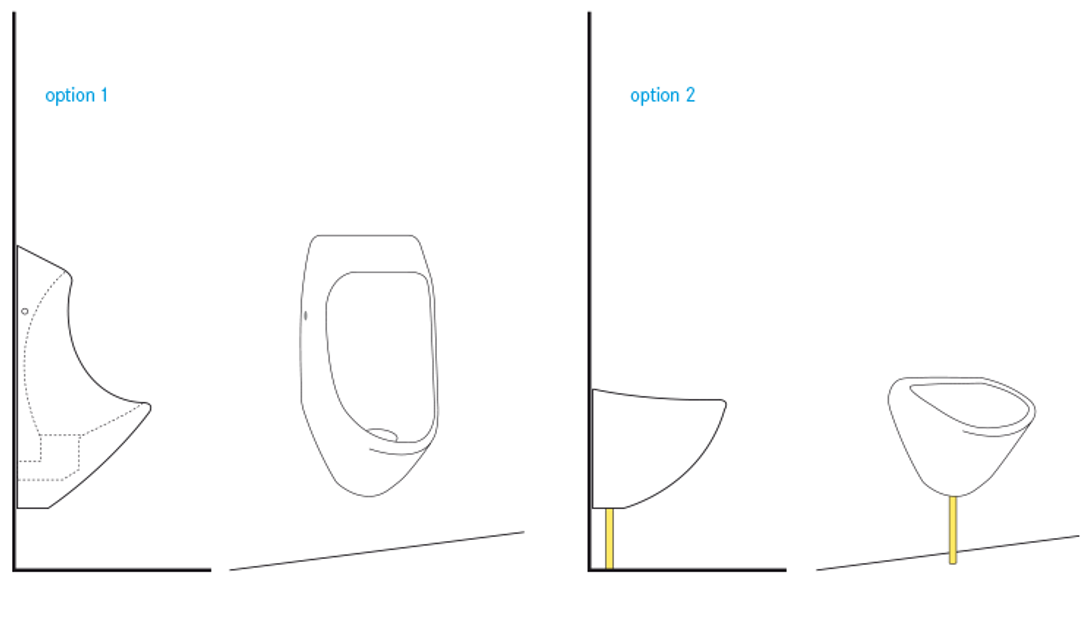
Urinals for women consist of raised foot-steps and a sloped channel or catchment area that conducts the urine to a collection technology. For men, urinals can be either vertical wall-mounted units, or squat slabs over which the user squats.
The urinal can be used with or without water and the plumbing can be developed accordingly. If water is used, it is mainly used for cleaning and limiting odours (with a water-seal). There are manual and automated flush techniques. Installing a flush urinal results in increased water consumption and the generation of the corresponding amount of wastewater. Waterless urinals have two important advantages compared to conventional water-flushed urinals: They save water (see also optimisation of water use at home) and they allow the collection of undiluted urine, which – because of its nitrogen and phosphorus content (see also the nutrient cycle or peak phosphorus) – is a valuable resource as fertiliser in agriculture (see also reuse of urine and faeces in agriculture, urine fertilisation small-scale and large scale).

Waterless Urinal with Rubber Tube Seal
(Adapted from MUENCH et al. 2009)
For this method, a flat rubber tube is used. This rubber tube is flat at the bottom when not in use (and hence blocks odour from the sewer or urine storage tank) but opens up when urine is flowing through. This one-way valve allows passage of grit up to 2 mm. Urine precipitates ("urine stone”), which stick to the rubber tube needs to be cleaned off with water regularly (otherwise the flat rubber tube does not close properly any more). The cleaning frequency depends on the number of uses per day (cleaning once per month under average circumstances may be sufficient). The rubber tube needs to be replaced around once a year. The rubber material is sensitive to solvents, acids, and deodorising tablets often used in urinals. Therefore, the use of acids or aggressive cleaning agents must be avoided. A low cost option for such a rubber tube seal is to use a condom and cut off a little hole at the bottom.
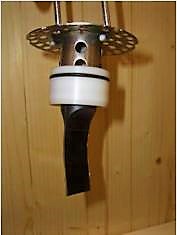
Water-less Urinals with Curtain Valve Seal
(Adapted from MUENCH et al. 2009)
The curtain valve seal is similar to the rubber tube seal, but was designed to reduce maintenance requirements. This type of one-way valve has “self-cleaning properties” as a small pressure difference forces the urine to wet the whole inner surface between the “curtains”, therefore flushing them clean. The element is designed in a manner to minimise build-up of urine precipitates or urine sludge and thus keeping the sealing surfaces clean. Like the flat rubber tube seal, this one-way valve also allows passage of grit up to 2 mm. The silicon curtain element is integrated into a plastic casing in order to guarantee that no odour from the sewer or urine storage tanks escapes into the room, and to allow an easy removal of the valve for maintenance purposes. For replacement of the curtain (if simple cleaning is no longer possible), the entire plastic casing is removed with a small plastic extractor tool, then discarded and replaced with a new valve. This replacement process may be necessary about once per year and takes only a few seconds. It can be performed without having to touch the valve element by hand.
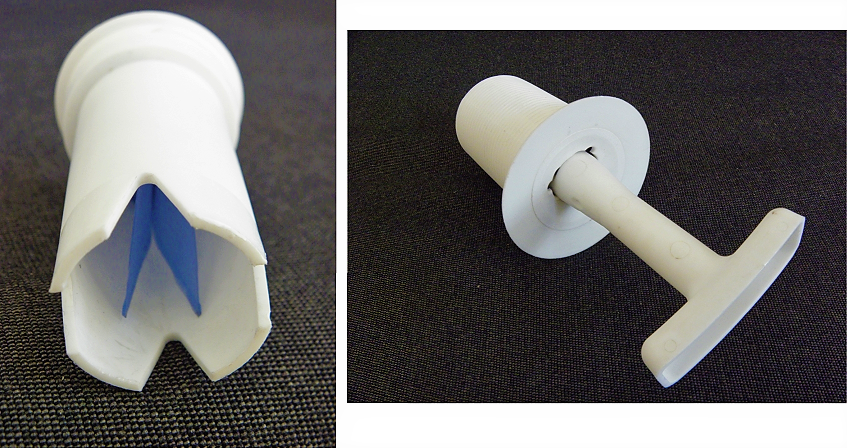
Water-less Urinals with Sealant Liquid
(Adapted from MUENCH et al. 2009)
This system works with a sealant liquid (also called blocking fluid), which is made of vegetable oils or aliphatic alcohols – they are biodegradable if released to the sewer or urine storage tank. The sealant liquid, with a specific gravity of around 0.8, floats on top of the urine contained in the trap and thus constitutes an effective odour barrier. Urine immediately penetrates the sealant liquid and flows to the drain. Urine precipitates are collected in a cartridge or inner cylinder of the trap. The maintenance program of waterless urinals with a sealant liquid consists of cleaning of the urinal bowl, and the regular exchange of the cartridge or the sealant liquid. The required exchange frequency depends on the number of users. With each use and in between uses, some urine precipitates accumulate which eventually renders the trap inoperative. Foreign objects, such as cigarette stubs, accelerate the process. At this point the cartridge has to be cleaned or replaced.
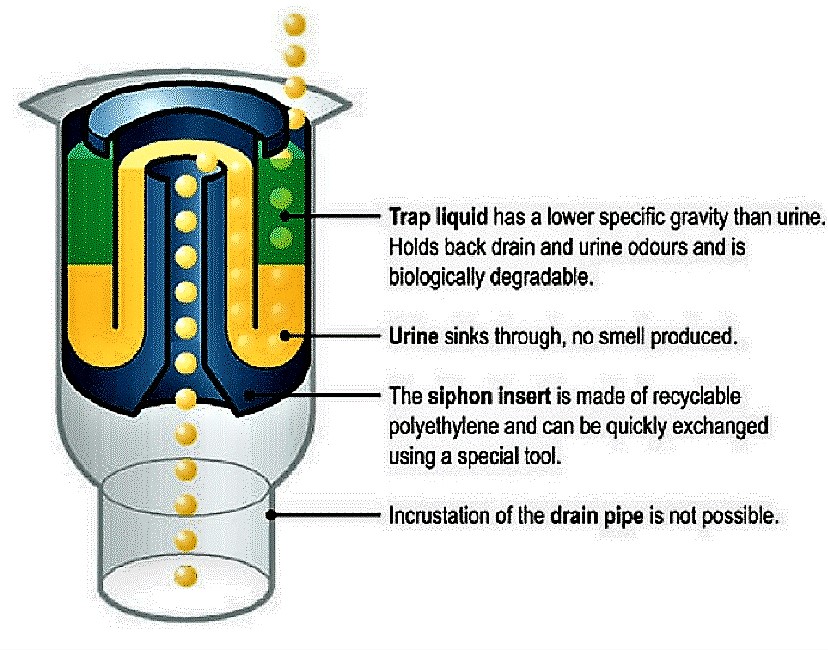
Low-cost Water-less Urinal
(Adapted from MUENCH et al. 2009)
Another very simple option for a waterless urinal is the “eco-lily”, also called “bidur” (in French) where a plastic funnel is inserted into the opening of a plastic jerry can. An old light bulb or a table tennis ball is placed into the funnel to act as odour seal (it should float up when urine enters the funnel but could end up sticking to the funnel). The disadvantage of the light bulb over the plastic ball is that the solder and metal cap on the light bulb contains heavy metals, which can contaminate the urine. The use of the light bulb or plastic ball as odour seal can also be used for other low-cost designs of urinals.
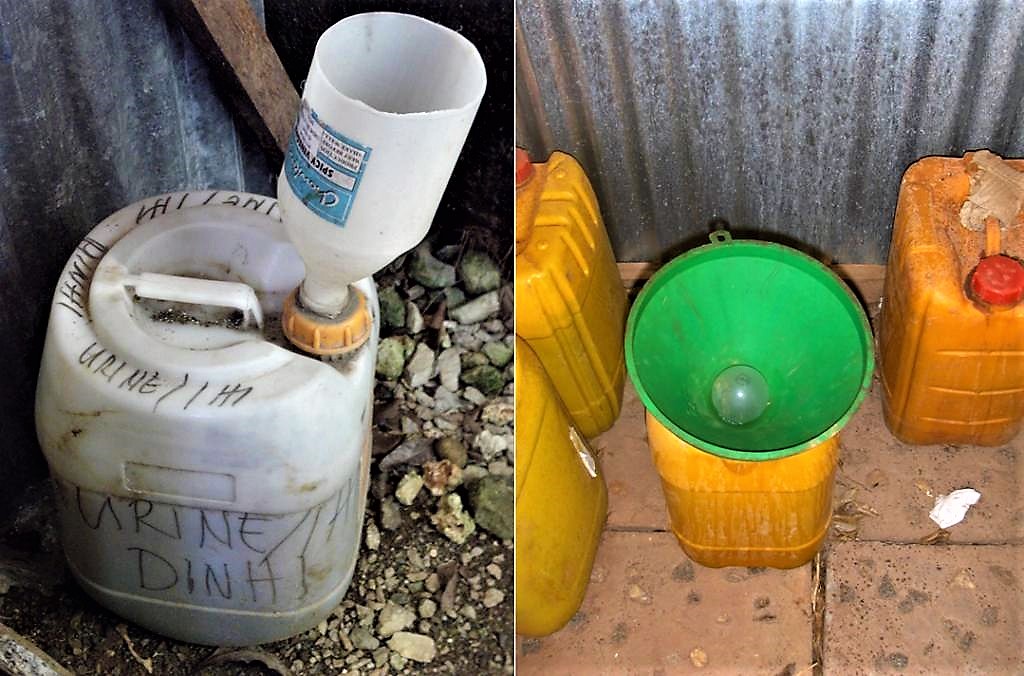
As for waterless urinals, there are several materials, which are used for flush urinals. These include porcelain, plastic, stainless steel or even cement. For flushing the urinal, there are four main technologies:
- Manual handles: each urinal is equipped with a button to activate the flush by touching a handle or a pedal that is located on the wall at ankle height (WIKIPEDIA 2011).
- Timing Switch: The most basic means of limiting flushing sees a timing switch connected to a traditional auto flush cistern. Groups of up to ten or so urinals will be connected to a single overhead cistern, which contains the timing mechanism. A constant drip-feed of water slowly fills the cistern, until a tipping point is reached, the valve opens (or a siphon begins to drain the cistern), and all the urinals in the group are flushed. Electronic controllers performing the same function are also used (WIKIPEDIA 2011; MAC and LLENNARG n.y.).
- Electronic Movement Detector: The most sophisticated system of all. Motion detectors are placed in front or behind the urinal and are connected to a valve in the water supply. They can be mains or battery operated (a battery can provide more than 2 years life). Devices are available for controlling conventional flushing cisterns or mains pressure flushing valves (MAC and LLENNARG n.y.).
- Door-regulated flush: A push-button switch is mounted in the door frame of the restroom, and triggers the flush valve for all restroom urinals every time the door is opened. While it can't detect the use of individual urinals, but compared to a timing switch, it provides reasonable flushing action without wasting excessive amounts of water when the restroom is not being used (WIKIPEDIA 2011).
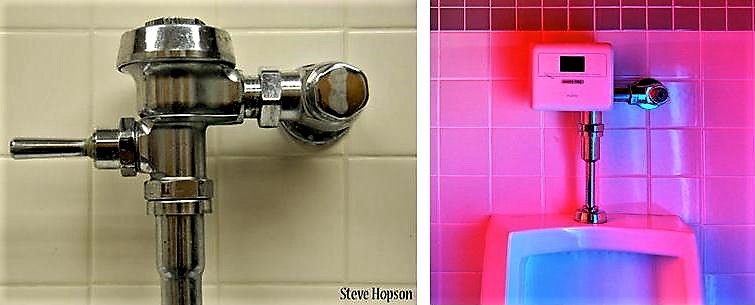
In many countries there is no treatment plant at the end of the sewerage system or the yellow water is discharged into an open drain from where it flows into an open water body such as a river, lakes, the sea or infiltrates into the groundwater (see also water pollution). Therefore, the waterless urinal is the more ecological solution.
For water-based urinals, the water use per flush ranges from less than 2 L in current designs to almost 20 L of flushwater in outdated models. Water-saving technologies such as high efficiency urinals or ultra low water urinals or waterless technologies should be favoured (see also toilet systems) . Furthermore there are vacuum urinals that also have very low water consumption but require energy. They can be installed as a VOD or a CVS system but this requires a permanent source of energy. To minimize odours and nitrogen loss in simple waterless urinal designs with urine collection tanks , the collection pipe should be submerged in the urine tank to provide a basic liquid seal.
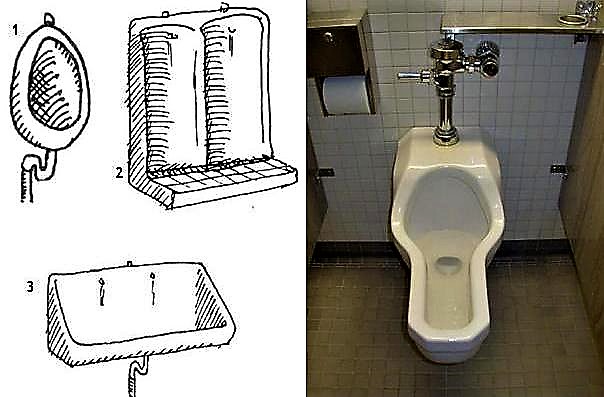
Waterless urinals are available in a range of styles and complexities. Some urinals come equipped with an odour seal that may have a mechanical closure, a membrane, or a sealing liquid.
By putting a small target, or painted fly near the drain, the amount of spraying or splashing can be reduced; this type of user-guidance can help improve the cleanliness of the facility. Because the urinal is exclusively for urine it is important to also provide a toilet to be used for faeces (here you can find information on other toilet systems) .
The urinal is a comfortable and easily accepted user interface. Although simple in construction and design, urinals can have a large impact on the well-being of a community (see also water sanitation and health, health risk management or water sanitation and development) . When men have access to a urinal, they may urinate less often in public, which reduces unwanted odours and makes women feel more comfortable. Men have generally accepted waterless urinals, as they do not call for any change of behaviour. For women, urinals are even more important, as for them, even the alternative of urinating outside is often impossible (e.g. on public markets in developing countries, see also water sanitation and gender). Especially if there is a manual handle for flushing, you should always clean your hands after you have been to a toilet/urinal (see also water sanitation and health or health risk management).
Maintenance is simple, but should be done frequently, especially for waterless urinals. All of the surfaces should be cleaned regularly (bowl, slab and wall) to prevent odours and to minimize the formation of stains.
Public urinals often contain a deodorising urinal block contained within a plastic mesh guard container or just openly on the plastic mesh guard. The plastic mesh guard is designed to prevent solid objects (such as cigarette, faeces, chewing gum or paper) from being flushed and possibly causing a clogging. Particularly, in waterless urinals, calcium- and magnesium- based minerals and salts can precipitate and build up in pipes and on surfaces where urine is constantly present. Washing the bowl with a mild acid (e.g., vinegar) and/or hot water can prevent the build-up of mineral deposits and scaling. Stronger (> 24% acetic) acid or a caustic soda solution (2 parts water to 1 part soda) can be used for removing blockages. However, in some cases manual removal may be required.
For waterless urinals, it is critical to regularly check the functioning of the odour seal.

Low-tech urinals are inexpensive. Self-built urinals can be made from a simple plastic container. Prefabricated plastic urinals produced in South Africa cost around 30 Euro per bowl without a stench trap. High tech urinals are more expensive; the investment costs are comparable with waterborne urinals. Service cost savings compared with waterborne urinals can be significant but are primarily dependent on water pricing and saved water quantity. Maintenance costs are similar to waterborne urinals (regular cleaning is sufficient) in case of urinals, which require no chemical replacement of odour trap, but higher for urinals which require chemical replacement of odour trap (see also operation and maintenance). Dependent on water price and saved water quantity, the payback on the installation costs is provided within a matter of months to years.
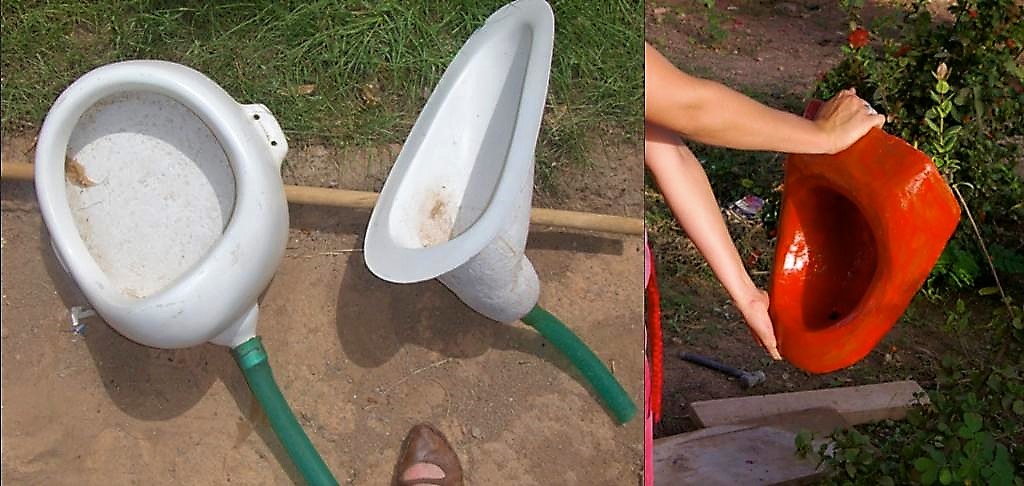
| Working Principle | A bucket, a wall mounted or a through urinal collects urine. In the case of flush urinals, the urinal is connected to a permanent water source that flushes the urine. Waterless urinals need no water for flushing and are therefore contributing significantly to water use efficiency. For the control of odour without siphons filled with water, the following technologies can be differentiated: oil barriers (either with refillable or replaceable cartridge), mechanical designs (one way valves), or microbial blocks.There are designs for men and women. |
| Capacity/Adequacy | Flush urinals can basically be built everywhere, but a constant source of water must be available. Waterless urinals are in widespread use in public and commercial buildings in countries with comparably high water price and/or where water savings in urinal installations is want to be achieved to the greatest possible degree (especially in public toilets), separated collection of undiluted urine is desired. |
| Performance | Depends strongly on user’s operation and maintenance. |
| Costs | Low-tech urinals are inexpensive. High tech urinals are more expensive; the investment costs of waterless urinals are comparable with waterborne urinals. In the case of flush urinals, however, the cost of water consumption has to be considered. |
| Self-help Compatibility | Self-built urinals can be made from a simple plastic container. Most other types of urinals cannot be manufactured locally. As for flush urinals, it might be hard to find spare parts. Because of the complexity of the flush mechanism, it is difficult to do repairs. |
| O&M | Any type of odour seal needs to be cleaned or replaced (if cleaning is no longer possible) at regular intervals to keep it fully functional. The frequency of cleaning or replacement depends mainly on the number of uses per day as well as user and cleaning staff behaviour. |
| Reliability | High, if maintained well. |
| Main Strength | Urinals are comfortable and hygienic for the user if cleaned regularly. Waterless urinals reduce water consumption (no flushing after urination) and allow for neat collection of urine for reuse as liquid fertiliser (after hygienisation) or reduced discharge of “yellow water” (i.e. urine water mixture) to the sewer and wastewater treatment system. |
| Main Weakness | Requires correct installation and regularly cleaning is required for an odour free operation. Flush urinals need water for flushing the urine. |
A flush urinal should not be considered unless all of the connections and hardware accessories are available locally. The flush urinal must be connected to both a constant source of water (can be a big problem and controversy in arid climates) for flushing, a collection/storage and reuse or conveyance and treatment technology.Waterless urinals are generally appropriate in any case because there are no rational disadvantages compared to waterborne urinals. Urinals can be used in homes as well as within public and commercial facilities. In some cases, the provision of a urinal is useful to prevent the misuse of dry systems (e.g. UDDT). Waterless urinals are in widespread use in countries with comparably high water price and/or where water savings in urinal installations is aimed at or separated collection of undiluted urine is desired. Portable waterless urinals have been developed for use at large festivals, concerts and other gatherings, to improve the sanitation facilities and reduce the point load of wastewater discharged at the site. In this way, a large volume of urine can be collected (and either treated and re used (see also storeage of urine, fertiliser from urine, reuse of urine and faeces in agriculture) or discharged at a more appropriate location or time or infiltrated for instance through a leach field ). The remaining toilets can be reduced in number or used more efficiently.
First time users of waterless urinals can be confused by the absence of a flush valve or water pipes. A display with educational information about the technology and environmental issues like the saved amount of fresh water can easily clarify confusion.
User acceptance is practically proven in case of correct installation and odour-free operation. Users may become negative about waterless urinals if they are confronted with poorly maintained urinals and exposed to unacceptable odour or hygiene issues.
Urine-diversion. Ecological Sanitation Systems in South Africa
This publication includes directions for making a simple urinal using a 5 litre plastic container.
AUSTIN, A. DUNCKER, L. (2002): Urine-diversion. Ecological Sanitation Systems in South Africa. Ecological Sanitation Systems in South Africa. Pretoria: Council for Scientific and Industrial Research (CSIR)A Guide to the Urinals
This book contains everything about urinals. Classification, technology and plumbing, urinals through history, film and literature and finally urinal etiquette and reference.
MAC, S. LLENNARG, C. (n.y): A Guide to the Urinals. URL [Visita: 10.10.2011]Waterless urinals: A proposal to save water and recover urine nutrients in Africa
Waterless urinals save water and they allow the collection of undiluted urine, which – because of its nitrogen and phosphorus content - is a valuable resource as fertiliser in agriculture. In the context of African developing countries, costs and maintenance requirements of waterless urinals need to be as low as possible. Despite the fact that hundreds of thousands of waterless (and odourless) urinals are now already in use worldwide, many municipalities are not yet aware of their existence or are reluctant to accept them as a viable option. This paper aims to reduce this knowledge gap by describing available models, odour control methods in waterless urinals (flat rubber tube, silicon curtain valve or sealant liquid), and the aspects to be considered regarding maintenance requirements and costs.
MUENCH, E. (2009): Waterless urinals: A proposal to save water and recover urine nutrients in Africa. Entradas: Proceeding of the 34th WEDC International Conference, Addis Ababa, Ethiopia, 2009: URL [Visita: 13.05.2019]Urine diversion components. Overview of Urine Diversion Components such as Waterless Urinals, Urine Diversion Toilets, Urine Storage and Reuse Systems
The publication explains the purposes of urine diversion, its benefits and challenges, possibilities of urine treatment and reuse in agriculture. It provides an overview on design and operational aspects for equipment needed, such as waterless urinals and urine diversion toilets. An appendix with a worldwide listing of suppliers for waterless urinals and urine diversion toilet pedestals and squatting pans is also available.
MUENCH, E., v. WINKER, M. GTZ (2009): Urine diversion components. Overview of Urine Diversion Components such as Waterless Urinals, Urine Diversion Toilets, Urine Storage and Reuse Systems. (= Technology Review ). Eschborn: German Agency for Technical Cooperation (GTZ) GmbH URL [Visita: 31.05.2019]Technology Review of Urine Diversion Components
The publication explains the purposes of urine diversion, its benefits and challenges, urine precipitation, urine treatment and reuse in agriculture. Further, it provides an overview on design and operational aspects for equipment needed, such as waterless urinals and urine diversion toilets including supplier information and indicative costs. Overall, it pulls together scattered knowledge around the topic of urine diversion in a concise manner.
MUENCH, E. von WINKER, M. (2011): Technology Review of Urine Diversion Components. Overview of Urine Diversion Components such as Waterless Urinals, Urine Diversion Toilets, Urine Storage and Reuse Systems. Eschborn: Deutsche Gesellschaft für Internationale Zusammenarbeit (GIZ) GmbH URL [Visita: 11.05.2019]Smart Sanitation Solutions
Smart Sanitation Solutions presents examples of low-cost household and community-based sanitation solutions that have proven effective and affordable. A wide range of innovative technologies for toilets, collection, transportation, treatment and use of sanitation products that have already helped thousands of poor families to improve their lives is illustrated.
NWP (2006): Smart Sanitation Solutions. Examples of innovative, low-cost technologies for toilets, collection, transportation, treatment and use of sanitation products. (= Smart water solutions ). Amsterdam: Netherlands Water Partnership (NWP) URL [Visita: 09.05.2019]Compendium of Sanitation Systems and Technologies. 2nd Revised Edition
This compendium gives a systematic overview on different sanitation systems and technologies and describes a wide range of available low-cost sanitation technologies.
TILLEY, E. ULRICH, L. LUETHI, C. REYMOND, P. ZURBRUEGG, C. (2014): Compendium of Sanitation Systems and Technologies. 2nd Revised Edition. Duebendorf, Switzerland: Swiss Federal Institute of Aquatic Science and Technology (Eawag) URL [Visita: 28.07.2014] PDFThe Women's Urinals of Texas A&M University
Compendium of Sanitation Systems and Technologies (Arabic)
This is the Arabic version of the Compendium of Sanitation Systems and Technologies. The Compendium gives a systematic overview on different sanitation systems and technologies and describes a wide range of available low-cost sanitation technologies.
TILLEY, E. ULRICH, L. LUETHI, C. REYMOND, P. SCHERTENLEIB, R. ZURBRUEGG, C. (2014): Compendium of Sanitation Systems and Technologies (Arabic). 2nd Revised Edition. Duebendorf, Switzerland: Swiss Federal Institute of Aquatic Science and Technology (Eawag) PDFLow-Cost Sustainable Sanitation Solutions for Mindanao and the Philippines. A Practical Construction Field Guide
After a brief introductory chapter on the Philippine sanitation situation and basic principles of sustainable sanitation, the manual focuses on the introduction of different low-cost sanitation solutions comprising the arborloo toilet, the 1-chamber and 2-chamber UDDT, hanging UDDTs, and the ecopee urinal. Each technology is briefly described by giving general information on how it works, operation and maintenance requirements, reuse or safe disposal options, and in which setting this technology might be appropriate. In addition, a picture-based guide on how to construct each technology is provided as well as the necessary technical drawings and rough cost estimates based on current prices. Since a sanitation system does not end with the toilet itself, the last chapter also provides information on the overall management of the system including collection, transport, treatment, and final reuse of urine, feces and composting products in agriculture.
GENSCH, R. MISO, A. ITCHON, G. SAYRE, E. (2010): Low-Cost Sustainable Sanitation Solutions for Mindanao and the Philippines. A Practical Construction Field Guide. Cagayan de Oro City: Xavier University URL [Visita: 31.05.2019]High-Efficiency Urinals (HEUs) U.S. and CANADA
This article explains what a high-efficiency urinal is and includes a list of water sense urinals.
KOELLER, J. GAULEY. B. (2009): High-Efficiency Urinals (HEUs) U.S. and CANADA. Yorba Linda and Mississauga: Koeller & Company and Veritec Consulting Inc. URL [Visita: 13.10.2011]A Guide to the Urinals
This book contains everything about urinals. Classification, technology and plumbing, urinals through history, film and literature and finally urinal etiquette and reference.
MAC, S. LLENNARG, C. (n.y): A Guide to the Urinals. URL [Visita: 10.10.2011]Water Use by Urinals
Urinals are found in men’s bathrooms of the commercial, industrial, and institutional (CII) sectors of society. If men’s restrooms account for a significant portion of a facility’s water budget and the urinals are older, a urinal retrofit may provide significant water savings for the facility. The types of urinals and their water use characteristics are described in this report. Information on the expected prevalence of these urinals is also presented along with information on urinal retrofit programs.
MARTIN, J. HEANEY, J. (2008): Water Use by Urinals. Gainesville: University of Florida URL [Visita: 10.10.2011]Waterless urinals: A proposal to save water and recover urine nutrients in Africa
Waterless urinals save water and they allow the collection of undiluted urine, which – because of its nitrogen and phosphorus content - is a valuable resource as fertiliser in agriculture. In the context of African developing countries, costs and maintenance requirements of waterless urinals need to be as low as possible. Despite the fact that hundreds of thousands of waterless (and odourless) urinals are now already in use worldwide, many municipalities are not yet aware of their existence or are reluctant to accept them as a viable option. This paper aims to reduce this knowledge gap by describing available models, odour control methods in waterless urinals (flat rubber tube, silicon curtain valve or sealant liquid), and the aspects to be considered regarding maintenance requirements and costs.
MUENCH, E. (2009): Waterless urinals: A proposal to save water and recover urine nutrients in Africa. Entradas: Proceeding of the 34th WEDC International Conference, Addis Ababa, Ethiopia, 2009: URL [Visita: 13.05.2019]Appendix 1 for technology review of urine diversion components
This document contains a worldwide list of suppliers for waterless urinals. The tables of suppliers provided here are not complete listings but give only an indication of available products. If you spot errors or omissions, please contact the authors at ecosan@giz.de. In the brackets below each listing the date for provision of the information/last update of information is given. Please be aware that not all information is from 2011. An entry in this list does not imply a recommendation by GIZ. Costs are indicative only.
MUENCH, E., v. WINKER, M. GIZ (2011): Appendix 1 for technology review of urine diversion components. Worldwide listing of suppliers for waterless urinals. (= Technology Review ). Eschborn: Deutsche Gesellschaft für Internationale Zusammenarbeit (GIZ) GmbH URL [Visita: 31.05.2019]Technology Review of Urine-Diverting Dry Toilets (UDDTs)
This publication offers a complete overview of UDDT functions, design considerations, common operation and maintenance issues and generalised installation costs. Its focus is on applications in developing countries and countries in transition, although UDDTs are also applicable in developed countries.
RIECK, C. MUENCH, E. HOFFMANN, H. (2012): Technology Review of Urine-Diverting Dry Toilets (UDDTs). Overview on Design, Management, Maintenance and Costs. (= Technology Review ). Eschborn: German Agency for Technical Cooperation (GTZ) GmbH URL [Visita: 11.05.2019]Compendium of Sanitation Systems and Technologies. 2nd Revised Edition
This compendium gives a systematic overview on different sanitation systems and technologies and describes a wide range of available low-cost sanitation technologies.
TILLEY, E. ULRICH, L. LUETHI, C. REYMOND, P. ZURBRUEGG, C. (2014): Compendium of Sanitation Systems and Technologies. 2nd Revised Edition. Duebendorf, Switzerland: Swiss Federal Institute of Aquatic Science and Technology (Eawag) URL [Visita: 28.07.2014] PDFHow to Manage Public Toilets and Showers
The purpose of this decision-making aid is to provide practical advice and recommendations for managing toilet blocks situated in public places. It is primarily aimed at local decision-makers in developing countries and at their partners (project planners and managers).
TOUBKISS, J. (2010): How to Manage Public Toilets and Showers. (= Six Methodological Guides for a Water and Sanitation Services' Development Strategy , 5 ). Cotonou and Paris: Partenariat pour le Développement Municipal (PDM) and Programme Solidarité Eau (pS-Eau) URL [Visita: 19.10.2011]Every drop counts. Environmental sound technologies for urban and domestic water use efficiency
The focus of this book is efficient water use in urban and domestic environments and the context is decision making about sustainable development of human settlements.
UNEP (2008): Every drop counts. Environmental sound technologies for urban and domestic water use efficiency. Osaka: United Nations Environment Programme (UNEP). URL [Visita: 06.05.2019]Child Friendly Schools. Location, Design and Construction
This chapter examines the planning and design of new spaces and environments for child-friendly schools and sets out quality planning standards for improving existing schools and temporary structures used as schools. It focuses on location, design, construction, operation and maintenance of new child-friendly schools and the important factors for renovating and adjusting existing schools to make them child-friendly. The approach centres on the child, the main user of these learning spaces and environments, with the understanding that family and community participation is fundamental for best results.
UNICEF (2009): Child Friendly Schools. Location, Design and Construction. Entradas: UNICEF (2009): Child Friendly Schools. New York: . URL [Visita: 28.11.2011]Urine as Liquid Fertilizer in Agricultural Production in the Philippines
This field guide has been developed to accommodate the ever-increasing demand for more detailed and scientifically backed information on how to use urine in agricultural production. It is intended primarily for practitioners and experts in the water, sanitation, planning, and agriculture sectors, as well as local and national government officials from the various sectors, NGO and individuals interested and working in the field of agriculture and sustainable sanitation in the Philippines and the wider Southeast Asian region.
GENSCH, R. MISO, A. ITSCHON, G. (2011): Urine as Liquid Fertilizer in Agricultural Production in the Philippines. Cagayan de Oro: Sustainable Sanitation Center Xavier University (XU), the Philippine Sustainable Sanitation Knowledge Node, the Philippine Ecosan Network, and the Sustainable Sanitation Alliance (SuSanA) URL [Visita: 07.05.2019]Application of Dry Urinals Study Report
Short description on the use of dry urinals in Germany based on long term testing.
DEMIRIZ, M. (2005): Application of Dry Urinals Study Report. Gelsenkirchen: Gelsenkirchen University of Applied Sciences URL [Visita: 10.08.2010]Novaquatis final report. NoMix – A new approach to urban water management
From 2000 to 2006, the cross-cutting project Novaquatis explored the potential of urine source separation – also known as NoMix technology. Novaquatis comprises nine work packages, largely organized around the various stages of a nutrient cycle (e.g. user acceptation, sanitary technologies, storage and transport, urine treatment and fertiliser production, micropollutants in urine, urine-based fertilisers). The final report contains the results of all working packages as well as a practical guide for interested NoMix user.
LARSEN, T. A. LIENERT, J. (2007): Novaquatis final report. NoMix – A new approach to urban water management. Duebendorf: Swiss Federal Institute for Environmental Science (EAWAG) URL [Visita: 12.05.2019]Urban Urine Diversion and Greywater Treatment System Linz, Austria
This case study discusses a medium-scale pilot project in a new urban area in Linz, Austria. General objectives were the creation of a sustainable settlement in a new city district (high demand for residential buildings) and the establishment of ecological buildings and low energy construction concepts. Among specific objectives was the implementation of innovative solutions for water supply and wastewater treatment with a reduction of the infrastructure costs for municipal wastewater treatment. Also, the aim was to establish a holistic sanitation approach enabling the use of nutrients contained in excreta or wastewater in agriculture and to research treatment of micropollutants in urine.
OLDENBURG, M. WERNER, C. SCHLICK, J. KLINGEL, F. (2009): Urban Urine Diversion and Greywater Treatment System Linz, Austria. (= SuSanA - Case Studies ). Eschborn: Sustainable Sanitation Alliance (SuSanA) URL [Visita: 24.09.2013]Sanitation Concepts for Separate Treatment of Urine, Faeces and Greywater (SCST) – Results
Report of a European project with the objective to develop new sustainable sanitation concepts that have significant ecological and economic advantages compared to conventional end-of-pipe-systems. For this purpose, a demonstration plant was constructed and analysed in order to generate experiences on design, installation and operation.
PETER-FROEHLICH, A. BONHOMME, A. OLDENBURG, M. (2007): Sanitation Concepts for Separate Treatment of Urine, Faeces and Greywater (SCST) – Results. EU-Demonstration projectWaterless urinal sheds in the inner city, Hamburg, Germany
In 1994 the BSU (“Office for urban development and environment”) developed a general concept for the construction and maintenance of the public toilets in order to reduce annual operation and maintenance costs. All urinals installed in Hamburg’s public toilets today are waterless urinals (instead of conventional water flushed urinals which use 4-6 L per flush). In eleven urinal sheds, urine storage tanks were also installed. This urinal sheds have reduced costs than the other public urinals and it is possible, that the collected urine will be used in agriculture in the future.
WINKER, M. GROENWALL, P.N. (2010): Waterless urinal sheds in the inner city, Hamburg, Germany. (= SuSanA - Case Studies ). Eschborn: Sustainable Sanitation Alliance (SuSanA) URL [Visita: 10.08.2010]Urine and brownwater separation at the GTZ main office building, Eschborn, Germany
This case study is about a demonstration project in the headquarters of GTZ in Eschborn, Germany. The project consists of 50 urine-diversion flush toilets, 23 waterless urinals and 10 m³ urine storage tank.
WINKER, M. SADOUN, A. (2011): Urine and brownwater separation at the GTZ main office building, Eschborn, Germany. (= SuSanA - Case Studies ). Eschborn: Sustainable Sanitation Alliance (SuSanA) URL [Visita: 12.05.2019]Waterless urinals: A proposal to save water and recover urine nutrients in Africa
Waterless urinals save water and they allow the collection of undiluted urine, which – because of its nitrogen and phosphorus content - is a valuable resource as fertiliser in agriculture. In the context of African developing countries, costs and maintenance requirements of waterless urinals need to be as low as possible. Despite the fact that hundreds of thousands of waterless (and odourless) urinals are now already in use worldwide, many municipalities are not yet aware of their existence or are reluctant to accept them as a viable option. This paper aims to reduce this knowledge gap by describing available models, odour control methods in waterless urinals (flat rubber tube, silicon curtain valve or sealant liquid), and the aspects to be considered regarding maintenance requirements and costs.
MUENCH, E. (2009): Waterless urinals: A proposal to save water and recover urine nutrients in Africa. Entradas: Proceeding of the 34th WEDC International Conference, Addis Ababa, Ethiopia, 2009: URL [Visita: 13.05.2019]Ecological sanitation within GTZs main building in Eschborn - A demonstration and research project
PDF-presentation on urine diversion flush toilet systems at the GTZ headquarter.
RUED, S. ; WERNER, C. (2007): Ecological sanitation within GTZs main building in Eschborn - A demonstration and research project. Entradas: Proceedings of the International Conference on Sustainable Sanitation: Eco-Cities and Villages, 26-31 August 2007, Dongsheng/Erdos: URL [Visita: 10.08.2010]Yellow is the new Green
This opinion contribution from Rose George published in the New York Times emphasises the enormous potential urine as a sustainable fertiliser source.
GEORGE, R. (2009): Yellow is the new Green. Entradas: The New Your Times: , 27. URL [Visita: 27.07.2010]http://www.berger-biotechnik.com/
German provider of pre-fabricated composting toilets.
http://www.dubbletten.nu
Homepage of a Swedish urine diversion flush toilet supplier (only in Swedish).
http://www.ecovita.net/
Ecovita is a U.S.-based ecological toilet supplier (waterless, urine separation flush toilets, urine diversion composting toilets, etc.).
Urinals
A short article about the water consumption of urinals and how it can be reduced.
http://www.flickr.com
SuSanA Flickr picture collection on Waterless Urinals.
http://www.novaquatis.eawag.ch/
Novaquatis – a cross-cutting Eawag research project was concerned with urine source separation as a new element in wastewater management.
http://www.saniresch.de/
This is the main homepage of the SANIRESCH project (SANItaryRecycling ESCHborn) which focuses on the treatment and recycling of the urine, brown- and greywater collected at the headquarters of the German Technical Cooperation (GTZ) GmbH in Eschborn, Germany.
http://www.schoolsanitation.org/
This toolkit makes available information, resources, and tools that provide support to the preparation and implementation of hygiene, sanitation, and water in school policies and projects.
http://www.separett.com/
International supplier of urine diversion composting toilets.
http://www.urinal.net/
This websites contains a large gallery of urinals from all over the world.
http://www.urinalology.net/
Urinalology.net is the home of urinalology on the web. Peruse this site to find out more about urinalology and to submit information about urinals you may have encountered. Here you also can find the book “A Guide to the Urinal”.
www.uritac.com
This company is manufacturing waterless urinal cartridges and ceramic urinal bowls in Turkey.
http://www.waterless.com/
Site of the waterless Inc., a producer of waterless urinals.
http://en.wikipedia.org
This Wikipedia article gives a great overview of urinals.
http://wostman.se/
Homepage of a Swedish urine diversion flush toilet supplier.
http://www.zeroflush.com/
Site of the Zero flush, a producer of waterless urinals, also containg information on cost savings.
A Better Toilet For A Cleaner World
The sanitation technology paradigm is under review, as past approaches are not sufficient or affordable to close the sanitation coverage gap. In 2011, the Bill & Melinda Gates Foundation (BMGF) launched the bold Reinvent the Toilet Challenge (RTTC) program to promote the development of radically new innovations to address the sanitation challenge on a large-scale. The RTTC is premised on the fact that ground-breaking improvements are required in toilet design and fecal sludge management to close the urban sanitation gap. The RTTC is focused on reinventing the flush toilet, a break-through public health invention that has not changed substantially since the first flush toilet patent was issued in 1775.


